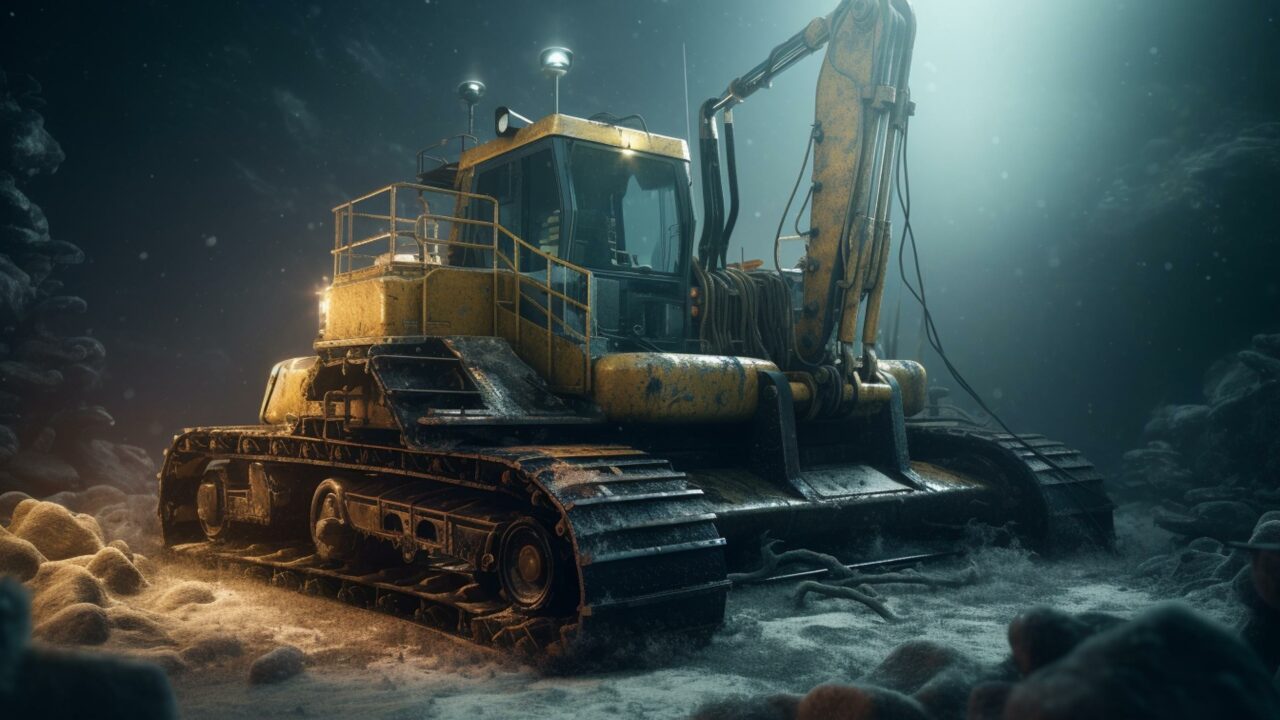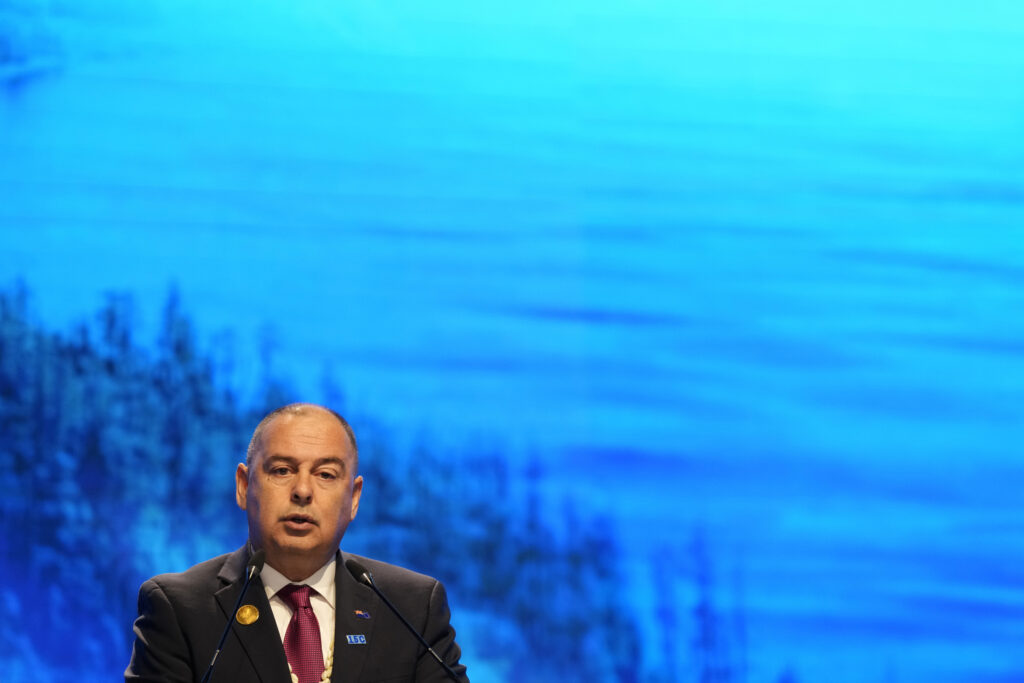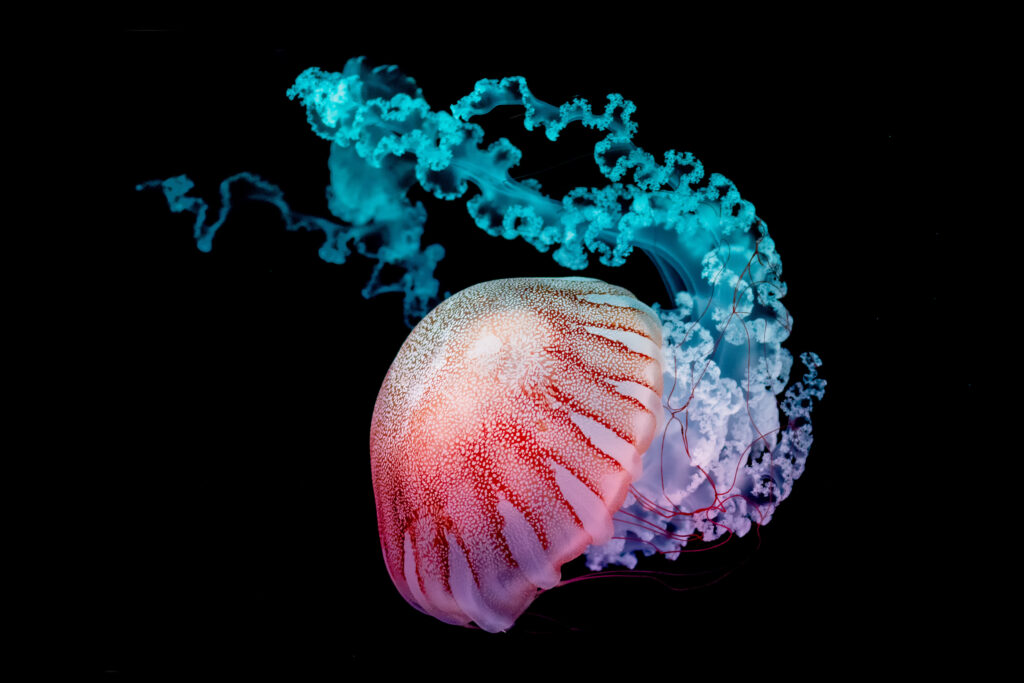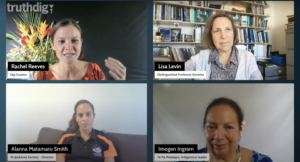Should We Be Mining the Ocean Floor?
The race is on to regulate an international competition for minerals in the world's least explored and most mysterious ecosystems. Image: Adobe
This is Part I of the "The Scramble for Deep-Sea Minerals" Dig series
Image: Adobe
This is Part I of the "The Scramble for Deep-Sea Minerals" Dig series
Miles beneath the surface of the ocean, about as deep as Mount Kilimanjaro is tall, things look a little peculiar. It’s a world freezing and dark, where the pressure is high enough to crack steel. The few humans who have visited those depths describe the environment as otherworldly.
Because it takes a long time for food — plankton, for example — to reach the deep sea, the animals there have evolved to conserve energy. They move slowly, reproduce slowly and live long. They look like Dr. Seuss creations — ghostly, spineless, strange — and have names like fangtooth, blobfish and vampire squid.
Beneath these beings of the deep lie the minerals that are crucial to the global transition to clean energy. The smallest deposits, known as polymetallic nodules, began as a nucleus — a sunken shark’s tooth, perhaps, or a fragment of a shell — and then, over what scientists believe was a period of 5 million years, accumulated layers of metals that had dissolved in the seawater. Larger mineral deposits take the form of polymetallic sulfides and cobalt-rich ferromanganese crusts, both the result of ancient volcanic activity.
What unites these deposits is their growing value to industries dependent on batteries that power our laptops, cellphones and electric vehicles, and that store energy created by solar, wind and other renewable energy systems. Only recently, with the global shift away from fossil fuels, have deep-sea deposits of cobalt, nickel and rare earths become valuable enough to justify the exorbitant cost of their extraction. Goldman Sachs Research forecasts that the percentage of electric vehicles in global car sales will increase thirtyfold — from 2% to 61% — by 2040. The International Energy Agency predicts demand for cobalt and nickel will quadruple by the same year.
Accessing these minerals is no simple matter. Companies in Europe and the United States are developing robotic vacuums that will suck up nodules and send them through a pipe to a ship for processing. These intruders into the most delicate and least-explored part of the planet could weigh 35 tons and measure nine by 12 meters.
Only recently, with the global shift away from fossil fuels, have deep-sea deposits of cobalt, nickel and rare earths become valuable enough to justify the exorbitant cost of their extraction.
Fears that broad swaths of international waters would be opened too hastily to seabed mining were somewhat assuaged in July, when the council of the International Seabed Authority (ISA), the body tasked with regulating access to deep-sea minerals in international waters, decided to postpone negotiations over regulations until November. The council has spent much of the last decade developing a mining code that will enable contractors, through sponsoring states, to apply for licenses to mine the high seas. The task of writing the code falls to the ISA’s legal and technical commission; the organization’s council must approve or reject it.
In mid-2021, then-president of Nauru, a Pacific nation measuring eight square miles, wrote to the ISA invoking its right, as a member state, to request the adoption of regulations within two years, as stipulated by the Law of the Sea. (The Law, which became effective in 1994, directs the ISA to act on behalf of “all mankind.”) The meaning of Nauru’s request was clear: the island’s government intended to start issuing mining licenses. This put a spotlight on the ISA council’s July meeting, scheduled for two years after the request was lodged.
The Metals Company of Vancouver, British Columbia, whose sponsoring state is Nauru, announced after the close of the ISA council meeting last month that while no regulations were approved, the corporation “reserves its right to submit an application for a plan of work in the absence of the adoption of the RRP’s,” or the rules, regulations and procedures that comprise a mining code. “It is now a question of when — rather than if — commercial-scale nodule collection will begin,” read a company press release.
Regardless of what happens at the ISA, nothing is stopping countries that control large areas of ocean, such as Nauru, Tonga, Kiribati, the Cook Islands and Norway, from mining in their territorial waters. Until the ISA finalizes regulations, the governments of these states are the guardians of the final frontier.
Advocates of deep-sea mining argue that it will be less destructive than mining on land. Most of the global supply of cobalt, for example, comes from the Democratic Republic of Congo, where watchdog organizations have documented child labor, among other abuses of human rights, and environmental degradation. Opponents counter that because humans understand so little about the deep sea, it’s impossible to estimate the impact of mining.
A May 2023 study published in Current Biology, a highly-regarded peer-reviewed scientific journal, estimated that around 90% of species in the deep sea are unknown. Researchers believe that within the Clarion-Clipperton Zone — a 1.7 million square-mile swath of ocean between Hawaii and Mexico, where nodules appear in dense concentrations and contractors have been prospecting for minerals — 5,580 species have been detected but only 438 have been identified.
What scientists do know, however, indicates that disturbing the seabed could have broad and unpredictable consequences. They know that more than 30% of the carbon dioxide produced by burning of fossil fuels sinks out of the atmosphere and through the ocean, toward the seafloor. They know that carbon-eating bacteria inhabit the deep sea, helping to mitigate climate change. They know that all species in the deep sea have lived for eons without any noise, movement or disturbance. “They’re going to be the most sensitive communities on the planet to these stresses,” said Dr. Craig Smith, who runs the Benthic Ecology Lab at the University of Hawaii.

Already the ISA has licensed 22 contractors to prospect for minerals in the Clarion-Clipperton Zone. Most are private companies that member states have sponsored, because while only countries can reap the riches of the sea, they are allowed to outsource the work to companies in exchange for a share of the profits.
The ISA has been criticized for aligning with the corporate interests that stand to benefit from lucrative government contracts. Michael Lodge, secretary-general of the ISA, appears in a promotional video from The Metals Company. “Land-based resources are becoming increasingly difficult to access,” he tells the camera. “We’ve taken the best resources already.” Observers ranging from Greenpeace to the ISA’s former top environmental staffer have noted a conflict of interest stemming from the ISA’s close ties to the companies it’s tasked with regulating.
Though negotiations at the ISA intensified only in the last decade, the international community has been discussing the commercial potential of the nodules for half a century. Discovered by the British survey ship HMS Challenger in the 1870s, deep-sea minerals weren’t seriously studied until nearly a century later, in 1957, when a collaborative international study of planetary systems revealed their abundance in the Pacific Ocean. In 1965, an American engineer published an economic forecast that made the minerals seem commercially viable.
In 1968, the United States Central Intelligence Agency embarked on what would become a portentous six-year operation. The search for deep-sea minerals was the cover story for an effort to locate K-129, a Soviet submarine with ballistic missiles aboard that had sunk in the Pacific. Though it failed to recover the sub, Project Azorian, as it was called, had an enduring impact. It pushed the U.S. government to fund the development of technologies that could operate in the deep sea’s forbidding environs.
Research into deep-sea minerals continued, in fits and starts, for several decades. But the task was akin to fishing from the top of the Eiffel Tower in a hurricane. Companies routinely lost costly technologies in accidents that presaged the June 2023 implosion of the Titan, the submersible ferrying tourists to the wreck of the Titanic, which killed all five passengers aboard. It remained too expensive to either study or exploit the deep sea, and expeditions waned.
What scientists do know, however, indicates that disturbing the seabed could have broad and unpredictable consequences.
Around the time of the Great Financial Crisis, the economics turned. Cobalt, often used for the cathode of lithium-ion batteries driving Teslas and iPhones, and manganese saw their prices soar. Corporations began applying more pressure on the ISA to adopt regulations. They also began courting the governments of the Pacific Islands, which control dense concentrations of nodules and are not obligated, like the ISA, to reach an international consensus before making decisions.
For a while, it looked like Papua New Guinea would be the first nation to mine the seabed. Canada-based corporation Nautilus Minerals was pursuing copper, gold, silver and zinc there, and Prime Minister James Marape boasted that deep-sea mining would make his country the “richest Black Christian nation” on the planet. Then, in 2019, Nautilus went bankrupt, sticking Papua New Guinea, which owned 15% of the project, with a debt of US$150 million.
The experience seemed to change Marape’s mind on the urgency of issuing regulations and approving concessions. At a meeting of Pacific Islands leaders in August 2019, he voiced his support for a moratorium on mining. The idea of a 10-year pause, adopted by the European Parliament in 2018, has recently gained momentum; its champions now include BMW, Microsoft, Google, Volvo, Samsung, France, Germany, Spain, Portugal, Chile, New Zealand, Costa Rica and the European Academies Scientific Advisory Council. But it remains hotly debated within the Pacific Island region, which is home to the world’s largest deposits of deep-sea minerals.
Some Pacific Islanders cite scientists’ concerns about developing a brand-new extractive industry as rising seas, overfishing, coral bleaching and plastic pollution are already threatening their livelihoods. Others worry about the imbalanced relationship between their tiny governments and multinational corporations connected to industries with dubious histories concerning human well-being, such as mining tied to conflict minerals, oil and gas drilling, and weapons manufacturing.
Their concern is not unfounded. Governments in less developed countries, including Panama and Venezuela, have been sued through the powerful but little-known investor-state dispute settlement system for denying environmental permits to corporate plaintiffs. Within this system, a three-person panel decides whether a government’s decision violates international trade agreements, which exist to reduce barriers to business. While the tribunal cannot trump sovereign laws, it does have the authority to grant damages to investors affected by those laws.
The Florida-based Odyssey Marine Exploration, one of the companies interested in the deep-sea minerals of the Pacific, sued Mexico for over US$2 billion in 2019 when the government denied a license for an offshore mining project. “It’s really a cautionary tale,” said Dr. Catherine Coumans, coordinator of the Asia-Pacific program at industry watchdog MiningWatch Canada. The company’s position was that Mexico’s decision had “frustrated the potential of a world-class resource development project.”
Other Pacific Islanders support deep-sea mining as a pathway to development that, they maintain, is potentially less destructive than tourism and selling fishing licenses. Some note the hypocrisy of people and organizations from countries that produced large emissions of carbon dioxide telling people in developing countries to conserve their resources, and particularly resources that are purported to help with the problems caused by those emissions.

“The very countries that destroy our planet through decades of profit-driven development and who to this day continue their profit-driven actions and neglect their climate change responsibilities are making demands for a moratorium on our ocean,” Mark Brown, prime minister of the Cook Islands, said in a speech at COP27, the international climate conference held in Egypt in November 2022. He continued: “It is patronizing and it implies that we are too dumb or too greedy to know what we are doing in our ocean. We know what we are doing to protect ourselves and to protect our ocean. Because so far, we are not getting what we need from those who are damaging our planet.”
The governments of Kiribati, Cook Islands, Tonga and Nauru are currently negotiating with deep-sea mining companies from Belgium, the United States and Canada. Kiribati controls 1.3 million square miles of ocean, an area larger than India; Cook Islands, Tonga and Nauru control territorial waters roughly the size of Mexico, Afghanistan and Poland, respectively.
While people all over the world continue to debate whether it’s wise to solve the problems wrought by extraction with more extraction, governments in the Pacific Islands prepare for mining.
The Republic of Nauru is an island east of Papua New Guinea with a population of 12,500 and a modern history defined by mining. Through colonization by Germany, Australia and Japan, the island was strip mined for phosphate, which was used to make fertilizer for industrial agriculture. For a couple of decades after Nauru gained independence in 1968, phosphate made some people rich; the island’s government bought hotels in New Zealand and Australia and an airline. The money is gone, but the environmental impacts remain. A 1999 report by Nauru’s Department of Islands Development and Industry called the island “one of the most environmentally degraded areas on earth.”
Nauru sought reparations from Australia in 1989 and settled out of court for AU$120 million. The government later made several controversial attempts to generate revenue, by becoming a tax haven and an immigrant detention center. It’s now a sponsoring state for The Metals Company. “I believe that Nauru will benefit greatly,” Baron Waqa, the country’s former president, said of deep-sea mining in a promotional video produced by The Metals Company.
While people all over the world continue to debate whether it’s wise to solve the problems wrought by extraction with more extraction, governments in the Pacific Islands prepare for mining. In the Cook Islands, the government contracted the redevelopment of a port and harbor in early 2022, a month before granting three companies licenses to prospect for minerals using large ships.
When the research vessels, outfitted with millions of dollars worth of equipment, arrived in late 2022 and early 2023, the government organized traditional blessing ceremonies, replete with chanting, drumming and a fire ritual. Prime Minister Mark Brown prayed over the ceremony. “I ask the good Lord to let your blessing be upon this ship and its crew,” he said. “May your strength pilot them, may your power preserve them and may your hand protect them. Amen.”
Your support matters…Independent journalism is under threat and overshadowed by heavily funded mainstream media.
You can help level the playing field. Become a member.
Your tax-deductible contribution keeps us digging beneath the headlines to give you thought-provoking, investigative reporting and analysis that unearths what's really happening- without compromise.
Give today to support our courageous, independent journalists.


You need to be a supporter to comment.
There are currently no responses to this article.
Be the first to respond.